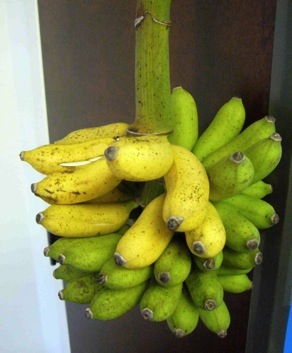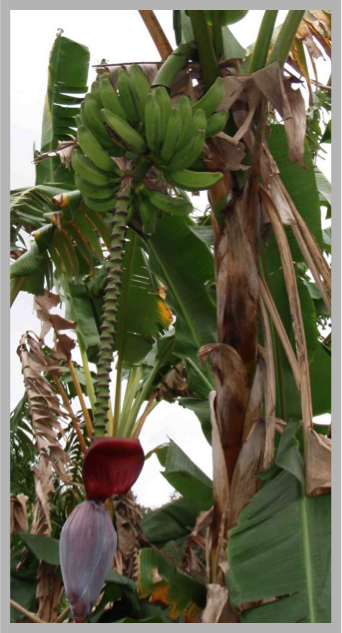Bananas Trees: Survival Food
Yes, everyone knows bananas are edible, as are their starchy cousins, the plantains. One doesn’t think of banana or plantain trees as weeds or a wild food but they are. More than that, as a survival food I know they can save lives. I’ve met several they’ve saved.
I have a friend who defected to the United States during the cold war. She did it while on tour as a national judo champion for Vietnam many years ago. She’s a pleasant woman, but not one to mess with for many reasons. She became a Judo champion in Vietnam after escaping Cambodia as an war orphan. The Khmer Rouge killed her entire family including cousins. At age seven she survived by traveling with other kids though the jungle from Cambodia to Vietnam living on whatever they could find for two years. There were just a few of them, none of them with any living relatives. They became their own family, and still are. In the jungle my friend learned that the banana tree provided more than just bananas.
Bananas are natives to Southeast Asia and are weeds. They’re also weeds in Florida. Many bananas have escaped cultivation, or were tossed in a compost heap and survived. I have planted a few cultivars and taken a few wild ones from hollows in abandoned orange groves. I have enough so that every year one or two will produce a stalk of fat, short, sweet citrusy bananas. Enter my friend: She still likes bananas.
As soon as one of my trees (correctly a pseudo-stalked herb) has a flower she lobs it off to take it home for a delicacy. She tells me my tree will have better bananas if she takes the blossom. I let her have them. I figure if she still likes them then she can have them. She earned the hard way the right to enjoy life.
The flower can be eaten raw or cooked. More so, the banana edibles don’t stop there. The core (and root stalk) of the banana’s trunk is also edible. It is used, notably, in the Burmese dish mohinga. Banana stalks are available year round where ever bananas grow. Incidentally, a juice extract of the core is used to treat kidney stones. Also, the sap of the tree makes an excellent glue as is. And I should mention the leaves. Banana leaves are large, flexible and waterproof. They can be used as umbrellas. One can often find holiday food wrapped in them in Oriental markets. Besides wrapping, they can be used to steam, roast, carry and pack food. They can be used as plates. They also contain a lot of oil and can be used like a frying pan to cook eggs.
And now a bit of botany. Bananas in the wild have seeds. Big seeds. There are about 1,000 different bananas and most of them have large, extremely hard seeds, from the size of a pea to the size of your thumb nail. More so, they also have bad tasting fruit. A natural mutation led to seedless bananas, but now the seedless ones are threatened by a fungus epidemic. In fact, in five years there might not be any seedless bananas. However, should you find a banana with seeds they can be ground into a flour. Should seedless bananas not disappear you can also make beer out of bananas… banana beer…No, I haven’t tried it, but I’m tempted.
There are two botanical names for most edible bananas. Commercial bananas are cultivars of the Musa acuminata. Musa (MEW-zuh) is from Arabic and means banana. Or, named for Antonius Musa (63-14-BC) a physician to the first Roman Empperor, Octavius Augustus. Acuminata (ah-kew-min-AY-tuh) means sharp pointed, I imagine for the pointy fruit. Most of the bananas grown on private plots are cultivars of the Musa balbisiana (bal-bis-ee-AH-nuh) which was named for Giovanni-Batista Balbis, a 19th century Italian botanist. The word “banana” also comes from the Arabic word “banan” which means “finger.” One banana has about the same nutrition as a potato.
Incidentally, there are two known banana allergies. If you are allergic to birch you will probably be allergic to bananas, or vice versa. That seems strange but it is a fact. Also, folks with a latex allergy can be allergic to bananas.
As for my friend… the ones that survived the jungle escape, the ones with no family… They call each other “cousin,” and they keep in touch, visit, help each other, a “family” forged out of hardship, not kinship. Many of them now live in the United States. I’ve met a few… and argue with none.
Sauteed Banana Tree Stem
Banana-tree-stem One pounds or so center core
Grated coconut – 1/4 of a coconut
Garlic cloves – 6
Chili powder – 1/4 tsp
Curry leaves – 1.5 teaspoons curry
Salt – to taste
Mustard seeds – 1/2 tsp
Coconut oil – 1 tablespoon
1) Peel off the outer layer of fiber from the banana-tree-stem and chop it into fine pieces. 2) Wash, drain and keep aside.
3) Heat half the oil in a pan. 4) Add mustard seeds and when they start to crackle 5) add the chopped banana stem pieces, curry, salt and chilly powder. For more yellow color add 1/4 teaspoon turmeric. 6) Cover with a lid and simmer until soft. This can take an hour or so. 7) Grind together the grated coconut and garlic in a mixer or blender. 8) When the stem pieces are almost cooked, add the coconut-garlic mixture to it and cook again with lid closed, till completely cooked. 9) When done, take off heat and sprinkle the rest of the coconut oil over the dish and mix. 10) Keep aside for a while with lid closed, before serving.
Banana Flower Stir Fry
* Banana flower – 1
* Lentils -1/2 cup
* Onion – 1 small
* Green chillies – 5 ( more /less according to ur taste)
* Garlic – 1
* Cumin powder – 1/4 tsp
* Turmeric powder – a pinch
* Coconut grated – 1/2 cup
* Oil -1 tbs
* Curry leaves
* Salt
METHOD:
* Cook the lentils, set aside.
* Remove the outside leaves (petals) until u get to the inside portion (cream edible portion) . Chop the edible portion finely . The chopped flower is in lumps because of the sticky fibrous material around it. To remove, apply a little coconut oil to your palm ,take a handful of chopped flower and rub to remove the lumps . Re-apply oil and repeat the procedure until you have removed all the lumps. Set it aside
* Dice the garlic
* Heat the oil in a pan and splutter mustard seeds. Add dry red chillies, chopped onion, green chillies, curry leaves and saute till the onions are light brown in color. Add the prepared flower, garlic, cumin powder, salt and turmeric powder . Cook it covered for 5 minutes in medium heat. Do not add any water. Add the cooked lentils and mix well. Cook for another 5 minutes until its completely dry. Note: Chopped banana flower can be soaked in milk to remove the bitterness.
Green Deane’s “Itemized” Plant Profile
IDENTIFICATION; Tallest herb on earth, often 12 feet high, leaves nine feet long comprised of upright concentric layers of leaf sheaths. Leaves can be to 12 ft (4 m) long and 3 ft (1 m) wide. The inflorescence is a long pendulous stalk bearing many purple bracts.
TIME OF YEAR: Year round in tropical and semi-tropical areas
ENVIRONMENT: Likes rich soil,well watered, sun and warmth. Landscape plant, back yard decoration. Often escaped, discarded or abandoned.
METHOD OF PREPARATION: Fruit raw, or cooked. Stem core and rootstock cooked, seeds ground in to flour. Banana leaves, stalks and skins can be burned to ashes to make a substitute for salt. The leaves can be used for cooking.



